64 Cores of Rendering Madness: The AMD Threadripper Pro 3995WX Review
by Dr. Ian Cutress on February 9, 2021 9:00 AM EST- Posted in
- CPUs
- AMD
- Lenovo
- ThinkStation
- Threadripper Pro
- WRX80
- 3995WX
CPU Tests: Rendering
Rendering tests, compared to others, are often a little more simple to digest and automate. All the tests put out some sort of score or time, usually in an obtainable way that makes it fairly easy to extract. These tests are some of the most strenuous in our list, due to the highly threaded nature of rendering and ray-tracing, and can draw a lot of power. If a system is not properly configured to deal with the thermal requirements of the processor, the rendering benchmarks is where it would show most easily as the frequency drops over a sustained period of time. Most benchmarks in this case are re-run several times, and the key to this is having an appropriate idle/wait time between benchmarks to allow for temperatures to normalize from the last test.
Blender 2.83 LTS: Link
One of the popular tools for rendering is Blender, with it being a public open source project that anyone in the animation industry can get involved in. This extends to conferences, use in films and VR, with a dedicated Blender Institute, and everything you might expect from a professional software package (except perhaps a professional grade support package). With it being open-source, studios can customize it in as many ways as they need to get the results they require. It ends up being a big optimization target for both Intel and AMD in this regard.
For benchmarking purposes, we fell back to one rendering a frame from a detailed project. Most reviews, as we have done in the past, focus on one of the classic Blender renders, known as BMW_27. It can take anywhere from a few minutes to almost an hour on a regular system. However now that Blender has moved onto a Long Term Support model (LTS) with the latest 2.83 release, we decided to go for something different.
We use this scene, called PartyTug at 6AM by Ian Hubert, which is the official image of Blender 2.83. It is 44.3 MB in size, and uses some of the more modern compute properties of Blender. As it is more complex than the BMW scene, but uses different aspects of the compute model, time to process is roughly similar to before. We loop the scene for at least 10 minutes, taking the average time of the completions taken. Blender offers a command-line tool for batch commands, and we redirect the output into a text file.
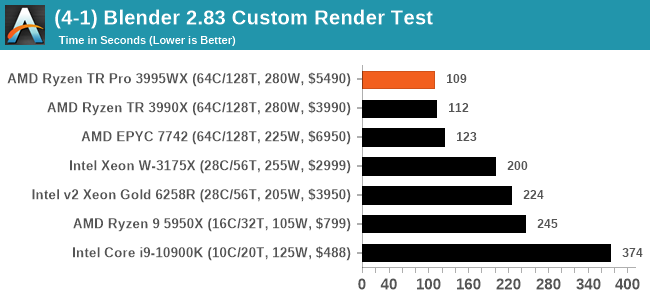
The first benchmark out of the gate and a win is scored by the TR Pro. It's only a small win at around 3%, but it showcases that the eight memory channels outweigh the extra frequency of regular Threadripper here.
Corona 1.3: Link
Corona is billed as a popular high-performance photorealistic rendering engine for 3ds Max, with development for Cinema 4D support as well. In order to promote the software, the developers produced a downloadable benchmark on the 1.3 version of the software, with a ray-traced scene involving a military vehicle and a lot of foliage. The software does multiple passes, calculating the scene, geometry, preconditioning and rendering, with performance measured in the time to finish the benchmark (the official metric used on their website) or in rays per second (the metric we use to offer a more linear scale).
The standard benchmark provided by Corona is interface driven: the scene is calculated and displayed in front of the user, with the ability to upload the result to their online database. We got in contact with the developers, who provided us with a non-interface version that allowed for command-line entry and retrieval of the results very easily. We loop around the benchmark five times, waiting 60 seconds between each, and taking an overall average. The time to run this benchmark can be around 10 minutes on a Core i9, up to over an hour on a quad-core 2014 AMD processor or dual-core Pentium.
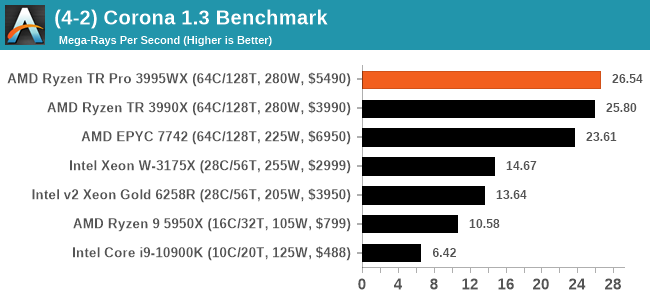
Another small 3% win in Corona, and almost double what Intel is offering.
Crysis CPU-Only Gameplay
One of the most oft used memes in computer gaming is ‘Can It Run Crysis?’. The original 2007 game, built in the Crytek engine by Crytek, was heralded as a computationally complex title for the hardware at the time and several years after, suggesting that a user needed graphics hardware from the future in order to run it. Fast forward over a decade, and the game runs fairly easily on modern GPUs.
But can we also apply the same concept to pure CPU rendering? Can a CPU, on its own, render Crysis? Since 64 core processors entered the market, one can dream. So we built a benchmark to see whether the hardware can.
For this test, we’re running Crysis’ own GPU benchmark, but in CPU render mode. This is a 2000 frame test, with medium and low settings.
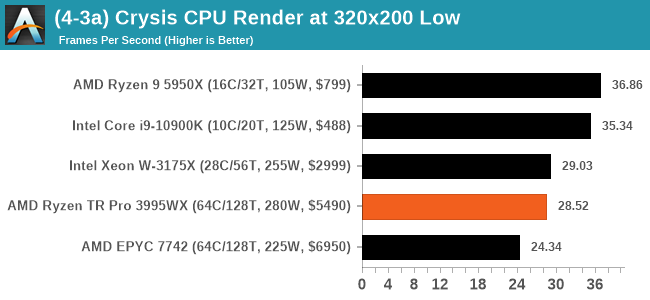
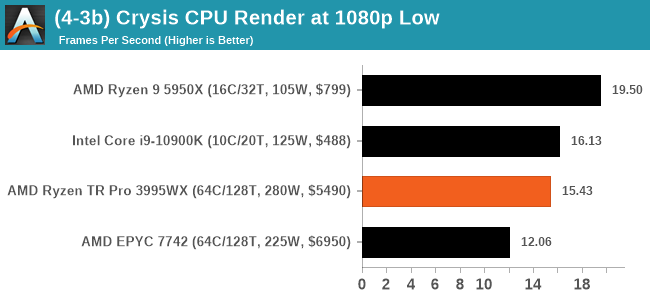
The Crytek engine used for Crysis has two key limitations: up to 32 threads, and up to 23 cores. As a result our high-end CPUs here are pegged to those cores, and single-thread limits come into play. The TR 3995WX has a healthy lead over the EPYC 7742, but loses out against the mainstream processors.
POV-Ray 3.7.1: Link
A long time benchmark staple, POV-Ray is another rendering program that is well known to load up every single thread in a system, regardless of cache and memory levels. After a long period of POV-Ray 3.7 being the latest official release, when AMD launched Ryzen the POV-Ray codebase suddenly saw a range of activity from both AMD and Intel, knowing that the software (with the built-in benchmark) would be an optimization tool for the hardware.
We had to stick a flag in the sand when it came to selecting the version that was fair to both AMD and Intel, and still relevant to end-users. Version 3.7.1 fixes a significant bug in the early 2017 code that was advised against in both Intel and AMD manuals regarding to write-after-read, leading to a nice performance boost.
The benchmark can take over 20 minutes on a slow system with few cores, or around a minute or two on a fast system, or seconds with a dual high-core count EPYC. Because POV-Ray draws a large amount of power and current, it is important to make sure the cooling is sufficient here and the system stays in its high-power state. Using a motherboard with a poor power-delivery and low airflow could create an issue that won’t be obvious in some CPU positioning if the power limit only causes a 100 MHz drop as it changes P-states.
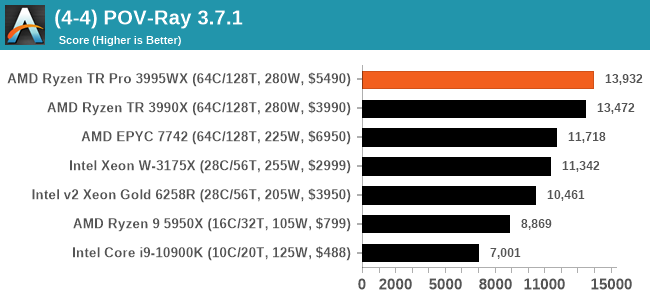
POV-Ray is another 3% win for the TR Pro 3995WX.
V-Ray: Link
We have a couple of renderers and ray tracers in our suite already, however V-Ray’s benchmark came through for a requested benchmark enough for us to roll it into our suite. Built by ChaosGroup, V-Ray is a 3D rendering package compatible with a number of popular commercial imaging applications, such as 3ds Max, Maya, Undreal, Cinema 4D, and Blender.
We run the standard standalone benchmark application, but in an automated fashion to pull out the result in the form of kilosamples/second. We run the test six times and take an average of the valid results.
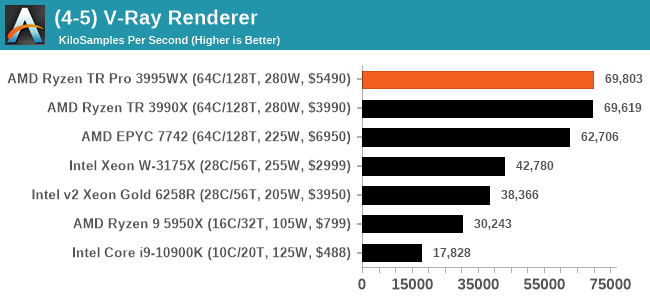
Less than 0.3% win here this time, but AMD's 64-core offerings are still ahead of the game.
Cinebench R20: Link
Another common stable of a benchmark suite is Cinebench. Based on Cinema4D, Cinebench is a purpose built benchmark machine that renders a scene with both single and multi-threaded options. The scene is identical in both cases. The R20 version means that it targets Cinema 4D R20, a slightly older version of the software which is currently on version R21. Cinebench R20 was launched given that the R15 version had been out a long time, and despite the difference between the benchmark and the latest version of the software on which it is based, Cinebench results are often quoted a lot in marketing materials.
Results for Cinebench R20 are not comparable to R15 or older, because both the scene being used is different, but also the updates in the code bath. The results are output as a score from the software, which is directly proportional to the time taken. Using the benchmark flags for single CPU and multi-CPU workloads, we run the software from the command line which opens the test, runs it, and dumps the result into the console which is redirected to a text file. The test is repeated for a minimum of 10 minutes for both ST and MT, and then the runs averaged.
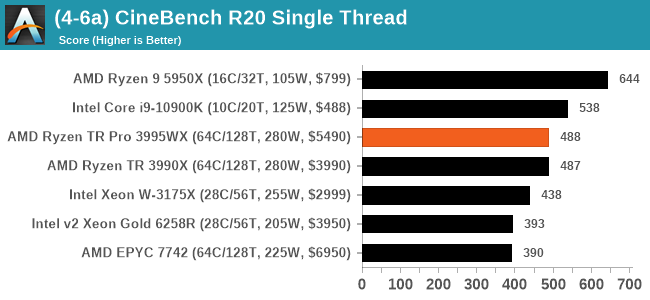
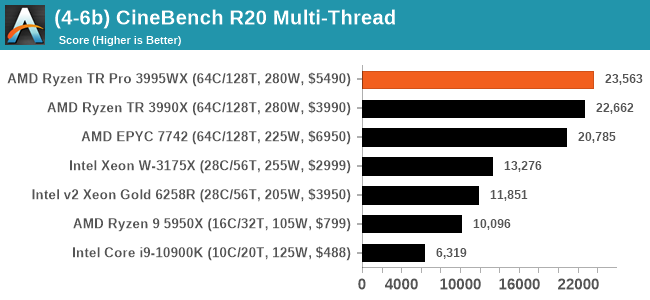
Cinebench ST scores are clearly in the realm of the mainstream processors, but when firing up all the threads, the TR Pro 3995WX takes a 4% lead over the standard 3990X, and scores 2.33x more than the mainstream 16-core Ryzen 9.



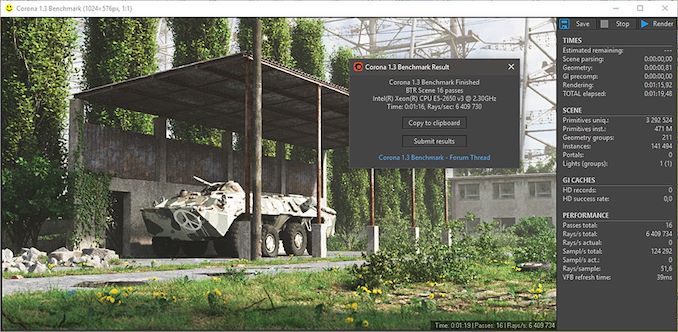



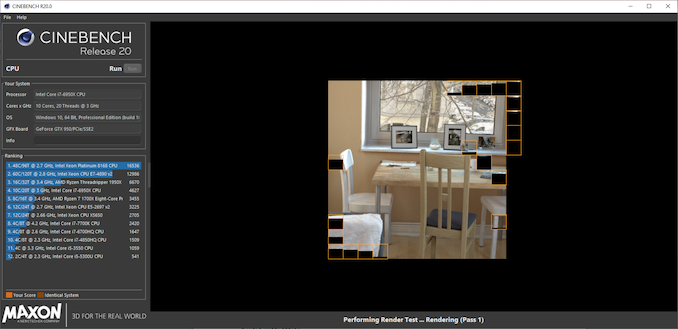








118 Comments
View All Comments
Silma - Tuesday, February 9, 2021 - link
TLDR: unless you absolutely need a 3995WX feature not included in a 3990X, the 3990X is a much better choice: almost same performances, $1,500 less.ingwe - Tuesday, February 9, 2021 - link
Yeah absolutely. Still exciting to me with the increased DDR capacity.kgardas - Tuesday, February 9, 2021 - link
Well, not always! For some cases W-3175x was better and even for some cases poor small 5950x was better. So target application always matter here.For me AVX512 perf of 3175x is breath taking (8x speedup of AVX512 code in comparison with non-AVX!) and pity that AMD is not supporting this yet. Speaking about spec. code, Saphire Rappids AMX will be something to look for.
frbeckenbauer - Tuesday, February 9, 2021 - link
It's unlikely amd will ever implement AVX512 directly. It's too niche and takes up a huge amount of die space, you're better off going to GPU instead.Oxford Guy - Tuesday, February 9, 2021 - link
If AMD were to implement it, Intel has AVX1024 waiting in the wings.Smell This - Tuesday, February 9, 2021 - link
Get me the Nuke Plant ... STAT!
We have an order for Chipzillah AVX1024, and need more Gigawatts.
kgardas - Tuesday, February 9, 2021 - link
Not avx1024, but amx: https://fuse.wikichip.org/news/3600/the-x86-advanc...ishould - Tuesday, February 9, 2021 - link
Is AMX something that might be able to be implemented as a chiplet? If so, AMD might be going this route so the customers that need it can get itElstar - Friday, February 12, 2021 - link
I can't find a link to it, but during the Xeon Phi era (rest in peace), the Intel engineers were proud of the EVEX encoding scheme and that it could support AVX1024 or AVX2048 someday. I think now that Xeon Phi is dead and normal Xeons have embraced AVX512BW and AVX512VL, this dream is dead too.kgardas - Tuesday, February 9, 2021 - link
Look at the benchmark numbers and then think what TR will be able to do with proper avx512 support. Yes, AMD definitely needs to implement it. Also it'll need to implement AMX in the future if they would not like to become second class x86 citizen again.